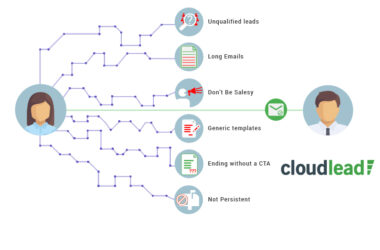A common problem SDRs and marketers face is email deliverability – which in simple terms refers to how likely it is that your email will be delivered to the recipient’s inbox.
Here’s the deal, you can certainly improve your deliverability/acceptance rate. In order to avoid your emails landing in spam folders or bouncing, senders should have authenticity with the subscriber’s internet service provider.
This means you have to be who you say you are; this is measured by some standard protocol methods. In turn, this reflects upon the reputation of the sender as well as the sender score that gauges the frequency of your email bounce rates, sending failures and spam traps.
Read: Why Emails Bounce: A B2B Marketing Perspective
Additionally, email deliverability check includes the content of your email; whether it is relevant to the sender and the subject line: remember you the aim is to get the recipient to open your email.
Before sending out marketing campaign emails or cold emails, there are a number of deliverability checks that can ensure inbox placement to a great extent.
They are categorized as follows:
Configuration of Account and Email
As the first step of your email deliverability check, you need to maintain the reputation of your domain and IPs.
For this, you should set up a separate account for outbound emails in order to filter the email traffic going in and out of your server. This helps ensure that your emails are being delivered to the recipients’ inbox.
Pro tip: It is better to send smaller campaigns along with keeping a sender score check using certain tools available online (explained further in the article).
Additionally, you should be aware of security mechanisms like SPF to avoid identity issues. Most importantly, keep track of the number of emails going out of your domain in case it exceeds the limit and trips an alert in some block list.
Content
The second step of your email deliverability check is the content and format of your emails; B2B cold email campaigns as well as marketing campaigns.
For starters, spam words and terms like “great offer” or “you have won” should be avoided. Email subject lines that have these words are likely to end up in the dreaded junk folder or could be mistaken as virus containing emails.
On the other hand, a touch of personalization to the email can do wonders. Every email should be concise and get the desired message across to the recipient.
The email should be followed by a professional looking signature and sign off message – believe me, every bit helps in achieving a good sender score rating.
Read: 5 Cold Email Templates For Generating Warm Leads
Contact Base
When launching a sales email campaign or a marketing campaign, it is essential to limit your contacts. For instance, it’s not the best idea to send cold emails to 10,000 prospects in a single day.
This means you are choosing quantity over quality which will reflect negatively on your sender score.
One way to run a good cold email campaign is to divide your B2B data list into batches of prospects and gradually send out emails in groups.
When doing so, you should make sure the emails are directed to business addresses of individuals as opposed to personal IDs to maintain a good sender score and as the last step of your email deliverability check.
Tools for Email Deliverability Check and Sender Score
The process of sending out emails and making sure they are read depends very strongly on the reputation of your domain which also has an impact on your sender score.
These are some tools that can be used to monitor your sender score:
-
-
- Senderscore.org is provided by Return Path and it rates you on a scale of 0-100 so the higher your score is the better your email deliverability check; which calculates your rating on a rolling 30-day average that indicates where your IP address ranks against others.
- Another sender score checking tool is Tallosintelligence.com which ranks you as Good, Neutral or Poor.
- ReputationAuthority by WatchGuard is specific to government organizations in providing them security from unwanted and spam emails as well as malicious code and spyware. Again, you can receive a sender score from 0-100.
- Similarly, Barracuda Networks is a database of good or blacklisted IP addresses that can be looked up in their Barracuda Reputation System.
-
While all of the above are different tools of check and balance, neither of them guarantees 100% reputation analysis or results. Being hands-on and carefully crafting/sending your emails is a must.
Remember, your email reputation is under your control – you just need to follow certain steps to ensure that you’re targeting your ideal buyers and sending personalized emails without spamming your list.
Additionally, by using certain resources such as an authentic data provider like Cloudlead and keeping a check on open rates, hard bounce rates etc., you can have more insights into how your prospects view your email and whether it is relevant to them.
At the end of the day, it is the interest generated by content sent to the right target audience that will improve your open rates, reply rates and hence, your sales.










